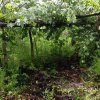landlord
5 year old buck +
How far west are you? I am 30 mi east of Eau Claire on county lineIf you were a little closer, I would help you out, but I don't have a trailer big enough to transport both the brush hog and tiller...
I'm a little sketchy when I transport just the brush hog....This picture is from before I bought my truck, so I would feel better putting more weight forward now to get more of the brush hog on the trailer.




